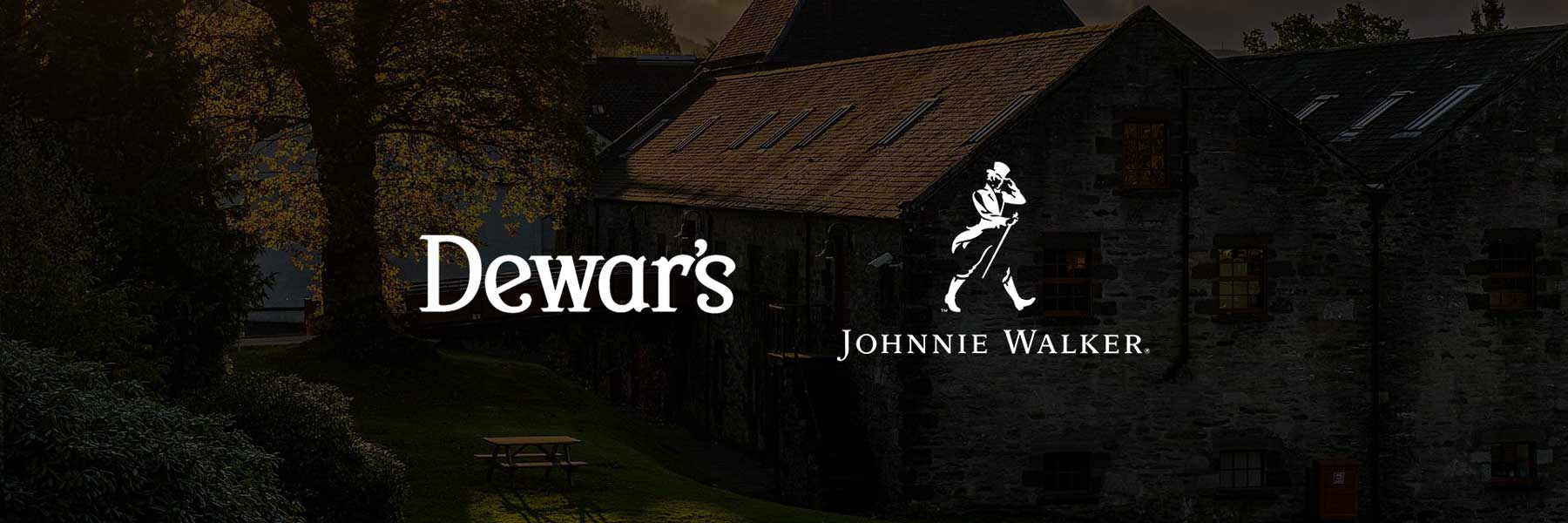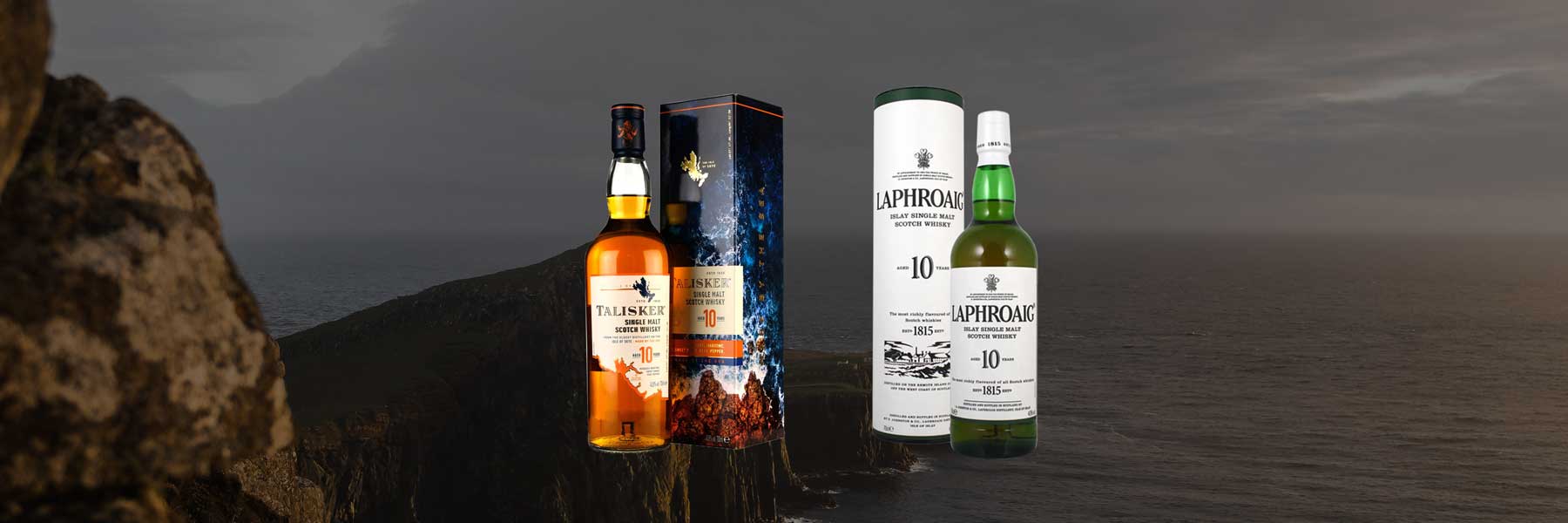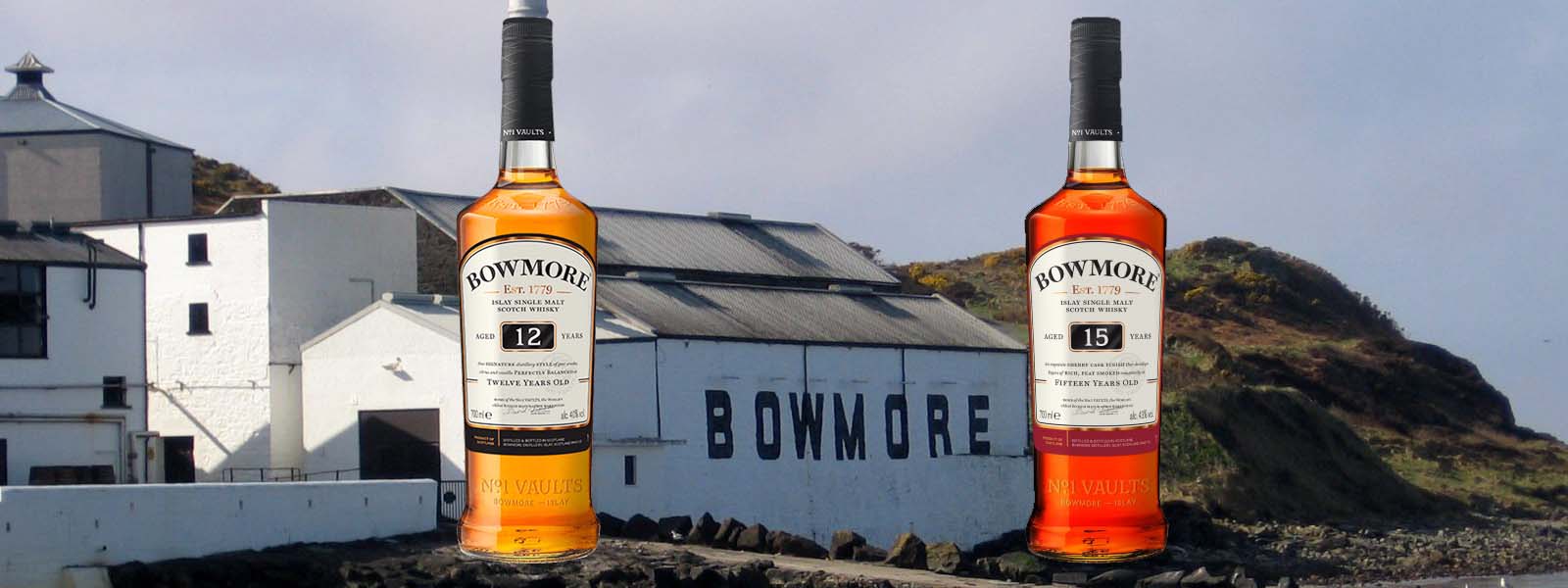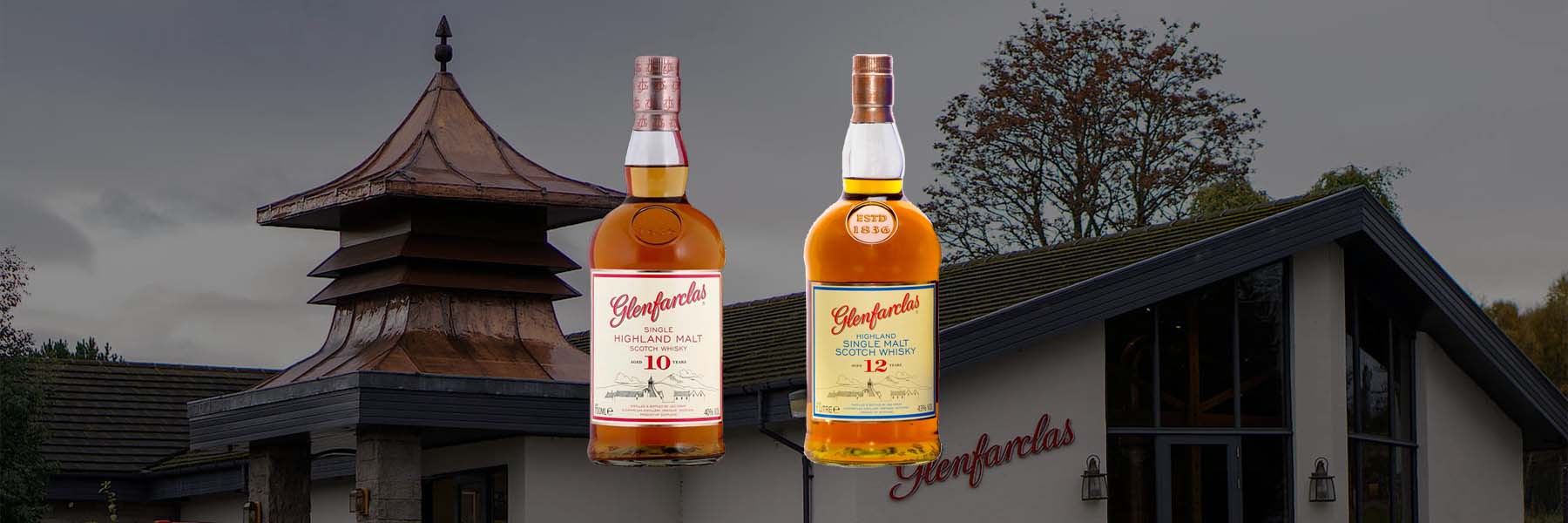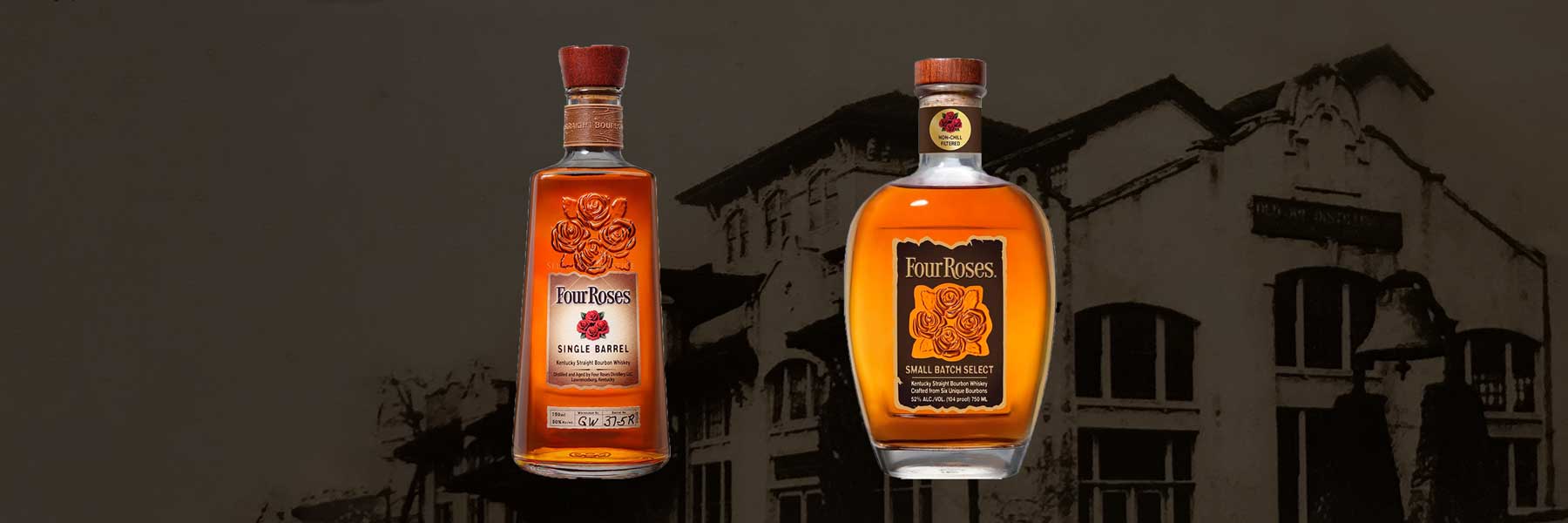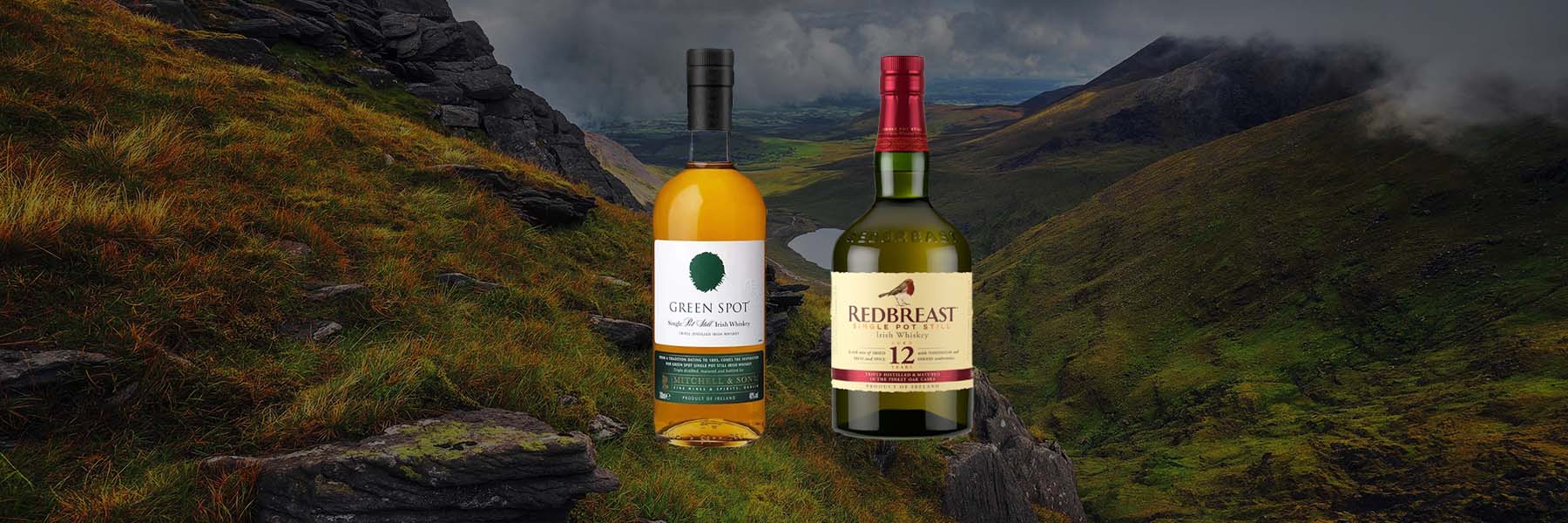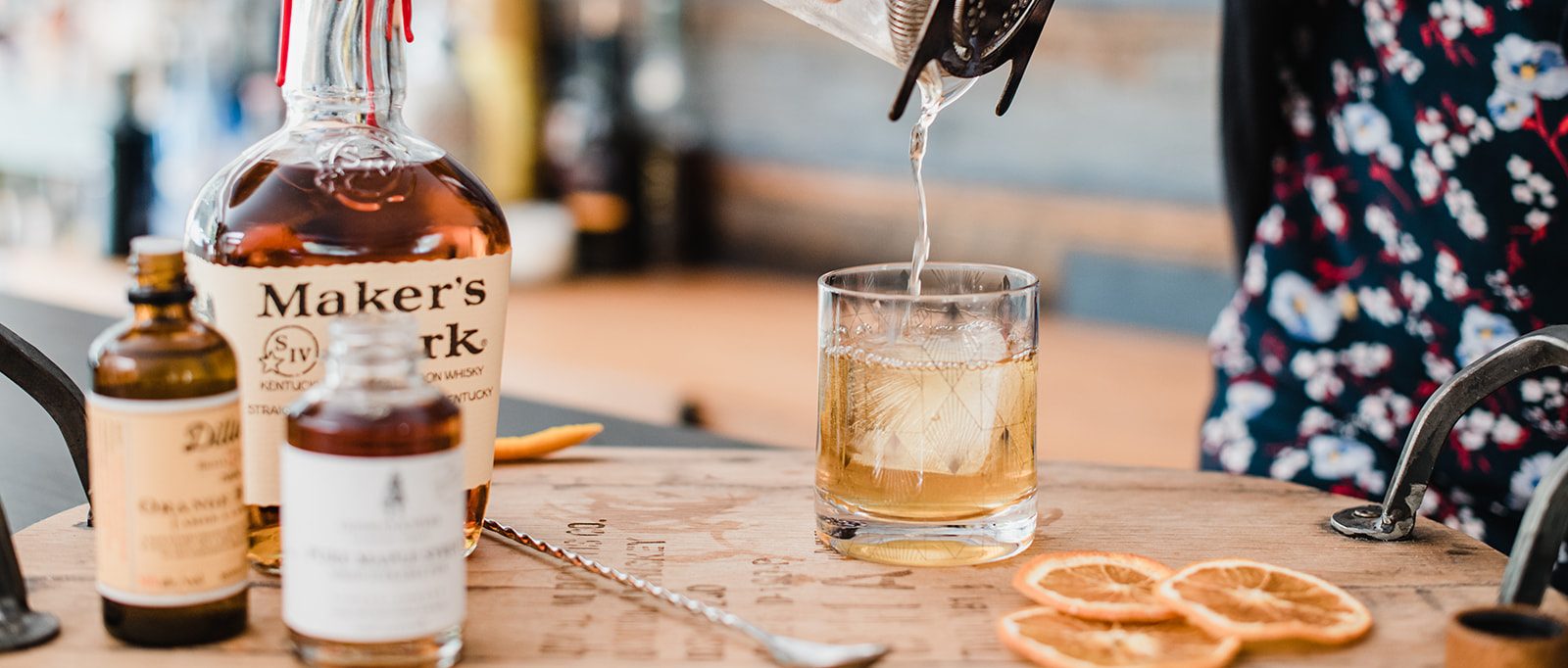Dewars vs Johnnie Walker | Comparing Scotland’s big blend brands and their core-range bottles.
When it comes to Scotch whisky, Dewar’s and Johnnie Walker are two of the most well-known brands. Both are internationally acclaimed, awarded and revered, offering a wide range of blended Scotches of varying ages, character and costs.
To help you navigate each brand’s whiskies, we’ve grouped their core-collection bottles into five simple tiers. Depending on your budget and personal tastes, this article should make sense of their signature bottles, outlining their key characteristics.
To jump ahead, click any of the tiers in the list below.
Quick brand overview
Dewar’s and Johnnie Walker are both blended Scotch whisky brands. They carefully select malt and grain whiskies from various distilleries around Scotland which they use to make their various ages of blended Scotch. Neither produce single malts.
Dewar’s are owned by Bermuda spirits company, Bacardi limited. Their blended whiskies are structured around Aberfeldy single malt, also made at the same distillery in Perth and Kinross, Scotland. Using around 40 whisky varieties, these comprise single malts and grain spirits in their blends. Dewar’s have 6 bottles in their core-range; their signature White Label, plus their 12, 15, 16, 18 and 25 year old expressions.
Johnnie Walker is Scotland’s top selling whisky brand, owned by international spirits giant Diageo. Their range is made using single malt and grain (wheat) whiskies from each region of Scotland. As many as 40 varieties are used for a single blend such as their renowned Black Label. Designed to express ‘the 4 corners of Scotland’ their flavours include light Lowlands, smooth Speysides, robust smoky Islays and floral Highland whiskies.
Johnnie Walker has a core-range of 7 bottles which are famously recognised by their iconic coloured and slanted label system. Red Label is their entry level bottle, accompanied by their Black, Double Black, Green, Gold, 18 and Blue Label whiskies (tiered in that specific order).
Dewars vs Johnnie Walker
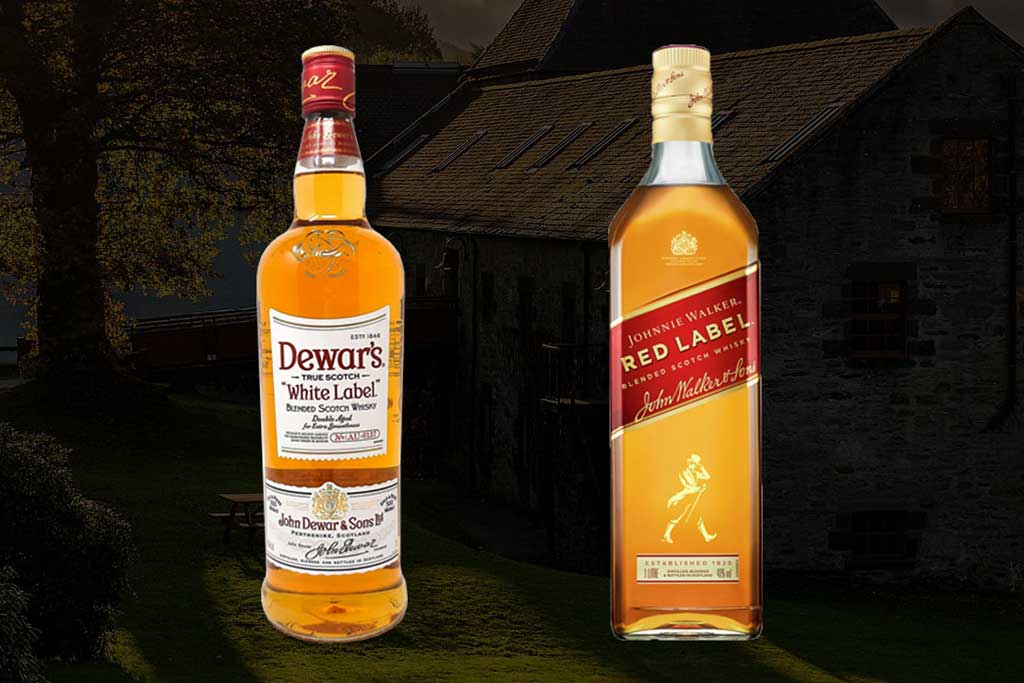
Dewar’s White Label vs Johnnie Walker Red Label
Dewar’s White Label is their entry-level, no-age-statement bottle within their core range, offering an affordable and accessible blend crafted from around 40 single malts and grain whiskies. This blend is double aged and is structured around the single malt from the Highland Aberfeldy distillery. It has an inviting nose of fresh orchard fruits with spices, honeyed sweetness and subtle oak influences on the palate. Dewar’s White Label offers great value for its price point; it’s sweet, smooth and surprisingly complex for it’s youthful age. Compared to Red Label, we deemed it our winner in this review.
Johnnie Walker Red Label is the entry-level bottle from their core range of blended Scotch whiskies. Primarily designed for mixing or for cocktails, it’s not what you’d consider a stand-alone ‘sipping whisky.’ Made using around 40 different single malts and grain whiskies, it’s an expression of ‘the four corners of Scotland’. On the nose, you can expect hints of smoky peat, sweet caramel and subtle oak influences. On the palate, you will taste a combination of light Lowlands whisky, smooth Speyside whisky, robust Islay whisky and floral Highland whisky.
Which bottle is better? Between these two entry level bottles, we’d suggest Dewar’s White Label as a stand alone sipper. It’s sweeter and more rounded than the Red Label, which is far more suited as a cocktail ‘base spirit’.
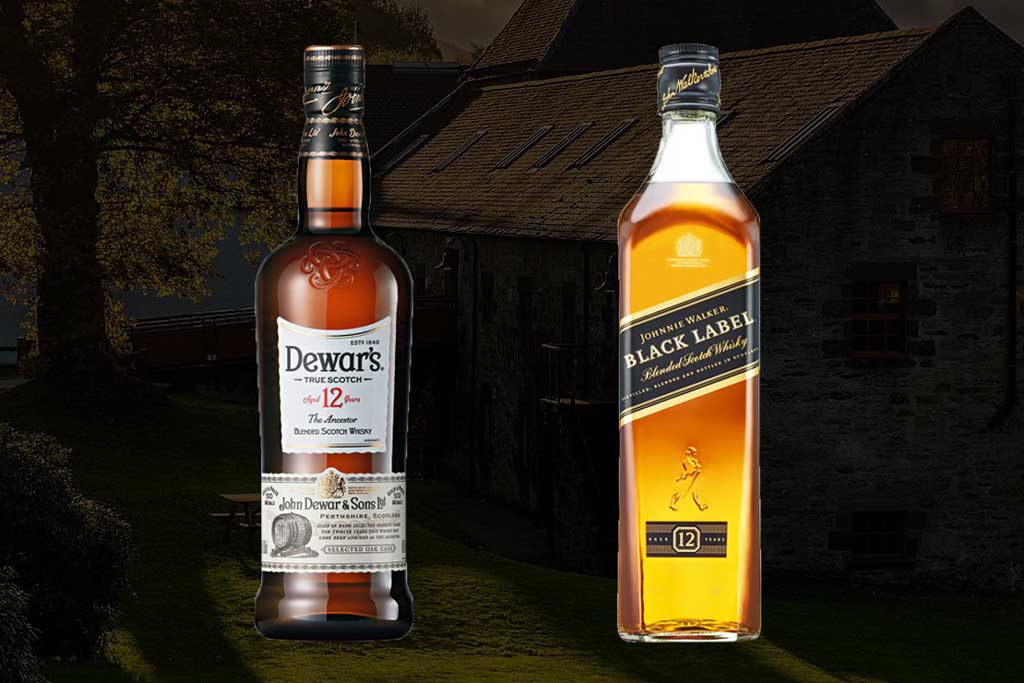
Dewar’s 12 vs Johnnie Walker Black Label
Dewar’s 12 year old whisky is positioned as a mid-level blended Scotch. This 12 year old expression is crafted with over 40 single malt and grain whiskies, using their signature Aberfeldy single malt as the key structure. Dewar’s 12 has a rich, full-bodied flavour palate which can be attributed to its double maturation process. (It’s spirits are aged separately, blended and then aged again.) On the nose, Dewar’s 12 has hints of citrus, dried fruits and subtle oak influences. The taste offers sweet honey and vanilla notes with a hint of spice, culminating in a smooth and balanced finish.
Johnnie Walker Black Label is an iconic Scotch whisky and one of the biggest names in the blend business. Aged for a minimum of 12 years, it has a balanced, mid-bodied flavour that comes from a staggering 40 single malt and grain whiskies from the four corners of Scotland. On the nose, you can expect hints of smoky peat, sweet caramel and subtle oak influences. On the palate you’ll taste a spicy, smoky combination with added notes of fruits and vanilla. It culminates in a smooth finish with great depth, making it an excellent choice for both sippers and mixers alike.
Which bottle is best?
These whiskies are both brand’s most popular bottles, each offering greater depth and complexity than the White/Red label entry levels. Between the two 12 year olds, we’d recommend Johnnie Walker Black Label for it’s sweet and smoky character. It’s got a little more depth than the Dewar’s and offer’s a smooth entry to the smokier, peatier flavours of blended Scotch. For it’s age and price, Black Label is a top contender within the category.
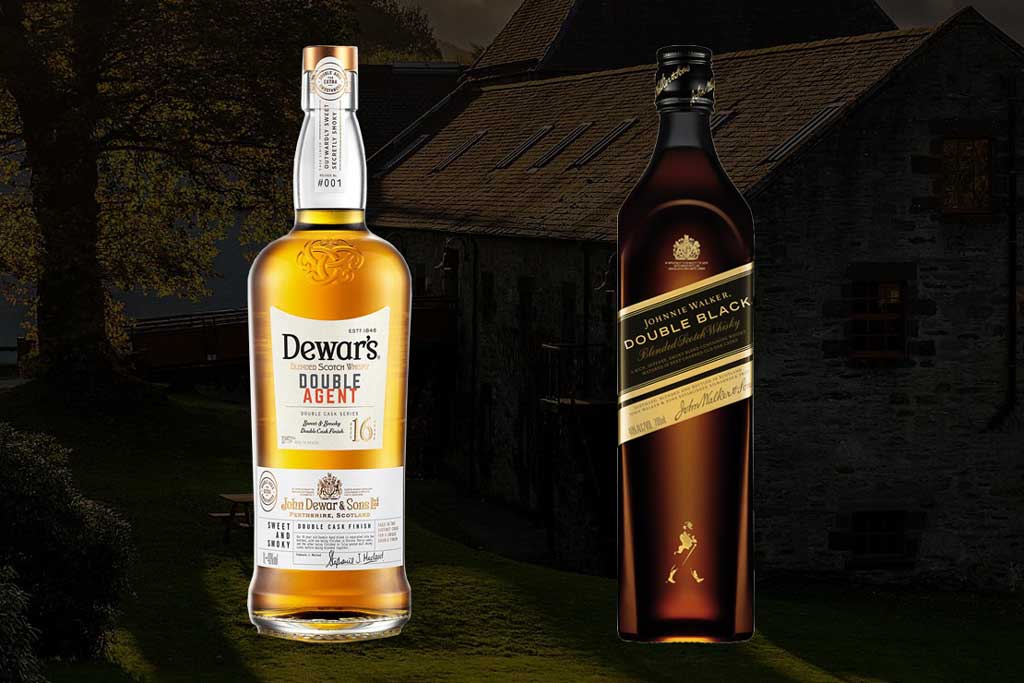
Dewar’s Double Agent vs Johnnie Walker Double Black
This unusual category contains outlier bottles within Dewar’s and Johnnie Walker’s core range. Each rather ‘irregular’ bottle has it’s own quirks which we urge you to discover in the descriptions below. If you’re looking for something a little unusual from either brand, these whiskies are worth discovering.
Dewar’s 16 whisky, also known as ‘Double Agent’ is one of the brand’s most recent, disruptive and unusual Scotch blends. Launched in 2022, the 16 has an intriguing two-stage maturation that intertwines sherry sweet with Islay peat. To begin, grain and malt whiskies are aged seperatley prior to blending. One married together, the whisky is aged again in oak casks before being divided (hence the name) into Jerez Sherry casks and smoky ex-Islay casks. Once more they’re aged for at least 16 years and re-blended to make a deliciously sweet but curiously smoky blend.
On the nose, the Double Agent has hints of toasted clove, nutmeg, and caramel; while the palate offers flavours of grilled peach, candied nuts, toffee, bold roasted malt and smoky Islay peat. The finish lingers with sweet orchard fruits along with singed oak notes. Dewar’s 16 is truly an intriguing and complex whisky that combines sweet notes of fruit, caramel and sherry with subtle smokiness from Islay peat. It’s an exquisite experience for any whisky lover.
Johnnie Walker Double Black
Although this whisky isn’t 16 years old, the NAS (no age statement) Double Black by Johnnie Walker is worth mentioning. Retired Master blender Jim Beveridge (succeeded by Emma Walker) designed this darker, broodier blend with smoky west coast malts in mind. Compared to Johnnie Walker’s typically light, malty and sweet profile, the Double Black has a much more boisterous demeanour.
Leaning more heavily on peated whiskies and extra-charred casks, this produces a much more prominent smoky character. Positioned as the ‘younger brother’ to the coveted Black Label, it’s a more peaty, fruity Johnnie Walker experience with wonderful malty, vanilla flavours.
Which bottle is best?
Not exactly a fair pairing, the Dewar’s is substantially older with a broader, more intricate maturation process over a minimum of 16 years. Between these two bottles, the Double Agent delivers a beautiful balance of sweet and smoke with the typical Dewar’s smoothness. Although the Double Black is a smoky delight, the Double Agent would be our top pick.
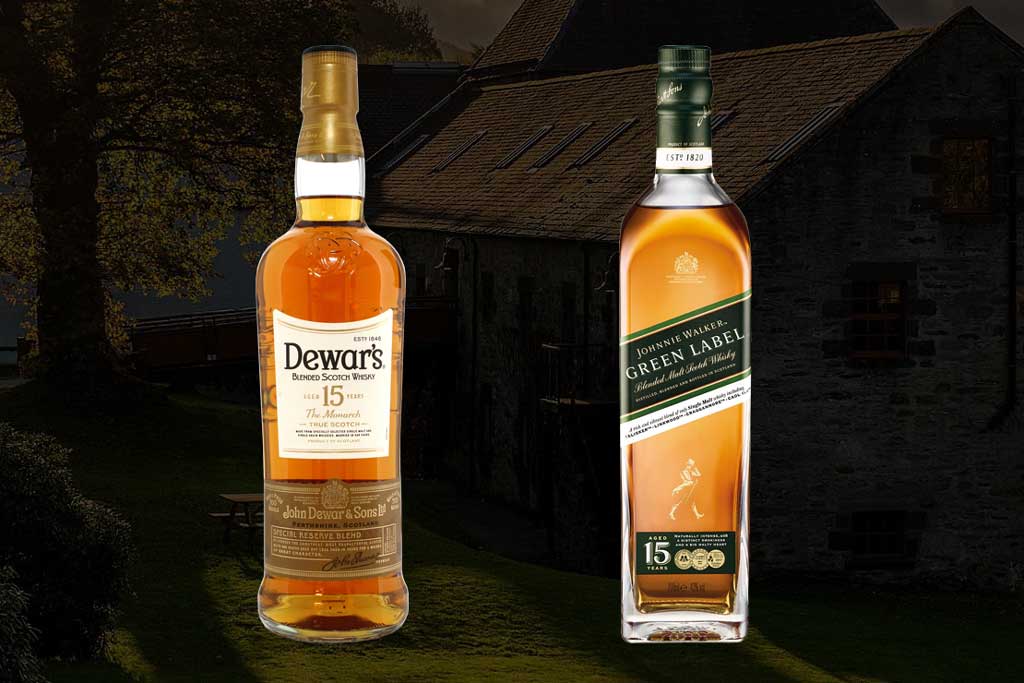
Dewar’s 15 vs Johnnie Walker Green Label
Dewar’s 15 year old blended Scotch whisky is a luxurious, premium expression that showcases the finest malts from the Dewar’s range. With its particularly regal name, ‘The Monarch’, Dewar’s 15 Year Old promises a complex taste profile of Sherried spices, nutty elements and a hint of apple skin on the nose. On the palate, oily walnuts lead into fresh malt and sultanas before ending with sweet dried fruit notes and a touch of grassiness on the finish.
Created to be a smooth and sweeter whisky than other Blended Scotch Whiskies, Dewar’s 15 Year Old is unique in that it is double aged using casks combined with Deward’s signature golden water source. This enhances its flavour notes even further, creating a rich blend of honey, toffee and delicate floral aromas. As such, Dewar’s 15 Year Old is full-bodied yet sophisticated; delivering superior quality for a very reasonable price.
Johnnie Walker Green Label is a unique specimen amongst their core range. Unlike their other bottlings, this 15 year old excludes grain whiskies and is made entirely of blended single malts, four of which come from the Talisker, Linkwood, Caol Ila and Cragganmore distilleries. It’s also their only bottle to exceed their typical 40% ABV percentage at a slightly stronger 43% ABV (86 proof).
The nose of this whisky boasts aromatic notes of freshly-brewed coffee, dark chocolate, sweet honey, toasty oak and smouldering peat smoke. On the palate, are dry cereals, light spices and roasted nuts that are pleasingly complemented by malty sweetness. The finish is long and smoky with a pleasant warming sensation.
Which bottle is best?
With the Green Label, you’re getting an ‘unofficial’ single malt of sorts. It’s a lovely balance of Islay and Speysides which intertwines delicate floral sweet notes with some woody, peaty and smoky undertones. Compared to the Dewar’s, its more earthy and herbaceous. For an oaky smoke fest, we’d choose the Green Label. For a lighter sweeter dram, go with the Dewar’s 15.
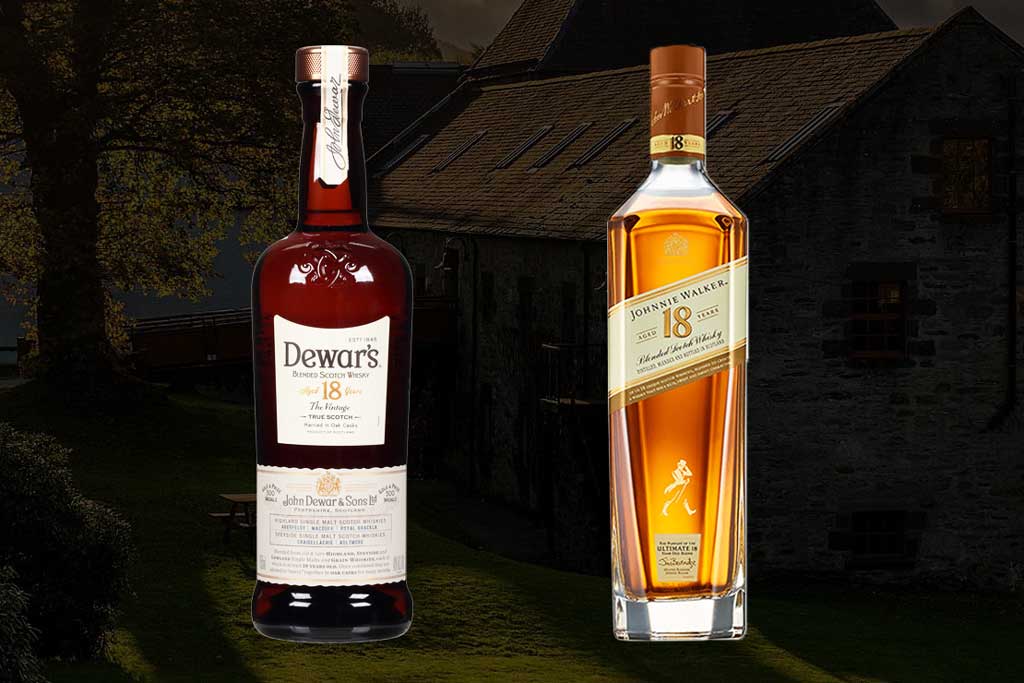
Dewar’s 18 vs Johnnie Walker 18
Dewar’s 18 year old blended scotch whisky is a true whisky connoisseur’s delight. Launched in 2003, it’s aimed as a much richer, decadent post-dinner style dram compared to the Dewar’s other younger bottles. On the nose, sweet grain aromas such as oats and freshly milled barley complement the grassy notes of hay and spring meadows. The palate reveals depths of flavour, with light florals and dried orchard fruits of pear, apple, fig and berries. There’s a mild hint of smoke to this whisky with a background nuttiness of marzipan which gives a pudding-like depth. An exquisite combination of sweet and smoke, Dewar’s 18 is sure to delight even the most discerning whisky drinkers.
Johnnie Walker 18 is a luxurious blend of Scotch whiskies and a true gem within the Johnnie Walker whisky range. Originally titled as ‘Platinum Label’ it consists of whiskies from the Cardhu, Glen Elgin, Auchroisk, and Blair Athol distilleries. On the nose, Johnnie Walker 18 Year Old presents an invitingly smoky aroma with fragrant spices like nutmeg and pepper blending together with sweet notes of honey and vanilla. The palate is creamy with subtle bitter notes of dark chocolate and waves of opulent spices such as cinnamon, cloves, nutmeg, pepper, and oak. Boasting a truly impressive flavour experience Johnnie Walker 18 Year Old is an exquisite expression sure to please any connoisseur or casual drinker alike.
Which bottle is best?
For a richer, more indulgent dram, we’d recommend the Dewar’s 18. It’s chocolate smooth flavours of fruit and marzipan are a decadent treat. Compared to the Johnnie Walker 18, it’s less spicy and has an almost brandy-like sort of quality to it. If you enjoy fruity whiskies, this charming bottle is the one for you.
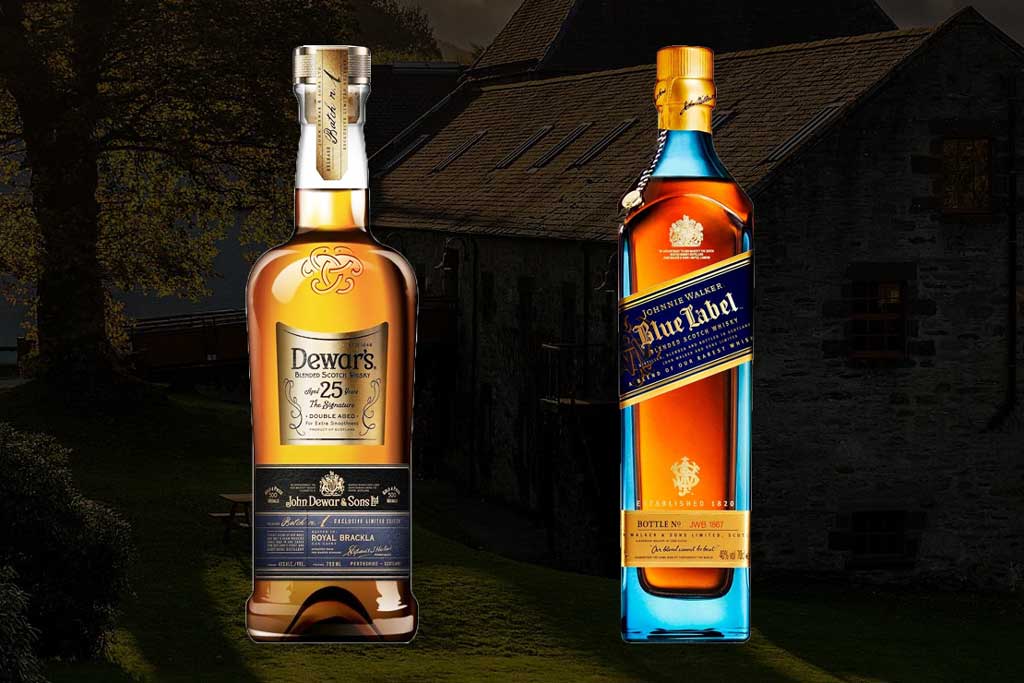
Dewar’s 25 vs Johnnie Walker Blue Label
Dewar’s 25 year old Scotch blend is the successor of their previous ‘Signature’ bottle, using a unique blend of single malt and grain whiskies. Positioned as their top-tier whisky within their core-range, it’s an exceptionally smooth, complex and luxurious drinking experience. Built on their core Aberfeldy single malt, it also contains whiskies from Aultmore, Craigellachie, MacDuff and Royal Brackla distilleries – including additional grain whiskies.
Resultantly, it has an inviting nose of honey, dried peels and toasted oak with a hint of strawberry jam and oak. On the palate, this whisky is rich with notes of Hobnob biscuits, red berry sweetness, sandalwood and treacle. The finish is a gentle build of Christmas spices with orchard fruit and mint leaf. At the peak of their permanent range, Dewar’s 25 Year Old is their pinnacle bottle.
Johnnie Walker Blue Label is a luxury blended Scotch created using some of the rarest and most exceptional whiskies within Diageo’s vast distillery portfolio. Positioned as their top-tier whisky within their core-range, the blend combines up to 18 different whiskies from Scotland’s most renowned distilleries. Only one in ten thousand casks meet the standard to be selected for making this ultra -premium Scotch, ranging anywhere between 25 and 60 years old.
The nose of the whisky has a rich, complex aroma with notes of oak, spice and sweet pastries. On the palate it is velvety smooth and mellow, with flavours of caramelised sugar, honeyed malt, smoky oak and grass. The finish is long and lingering, with subtle notes of sherry, dark chocolate and a hint of smokiness.
As premium Scotch blends go, Johnnie Walker Blue Label offers a truly luxurious whisky experience that showcases the very best in Scotch whisky distilling techniques.
Which bottle is best?
Compared to Dewar’s 25 year old, Blue Label is a very different proposition. Thanks to powerful marketing and years of compounding hype, Blue Label is understandably a highly sought after and coveted whisky. With such a compelling and vigorous selection process from Diageo’s malt empire, the whiskies that go into this bottle are second-to-none. That said, Blue Label will set you back a handsome £180 ($220USD) if you fancy a bottle. Of these two exceptional bottles, it’s a tough decision – but Blue Label is one of those ones to ‘try before you die’.
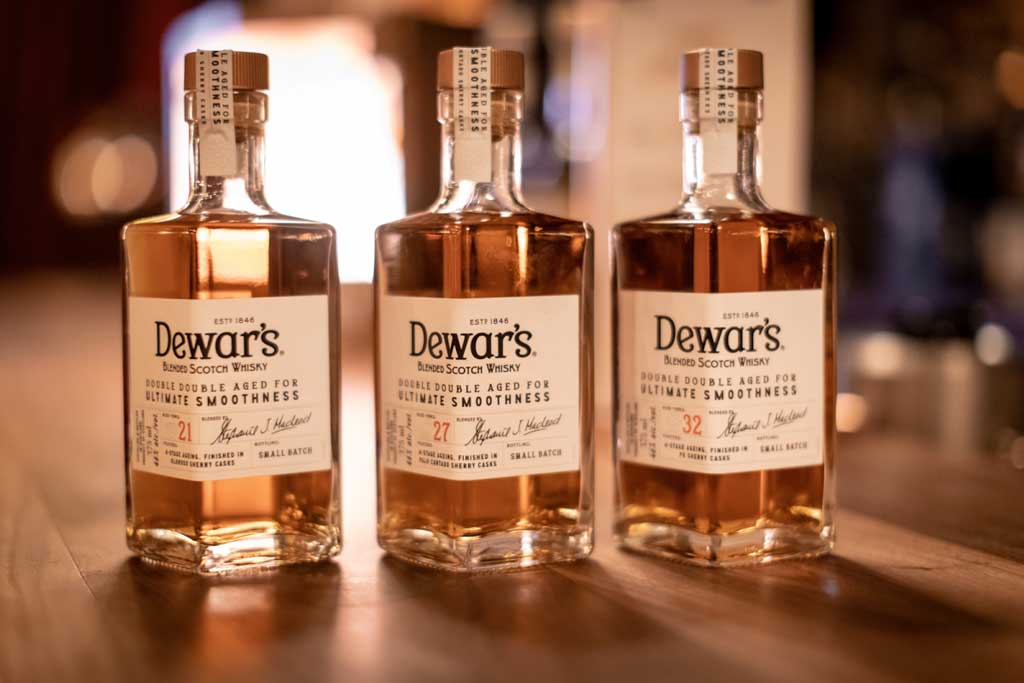
Other bottles you should know about
Dewar’s Double Series
In 2019, Dewar’s extended their range of whiskies with an award winning trio of double-double aged whiskies. Brainchild of Dewar’s Master Blender, Stephanie Macleod, these whiskies undertake a four-stage ageing process that’s truly something special.
The series contains three bottles; a 21, a 27 and a 32 year old, all of which go through the intricate multi-step blending and ageing processes.
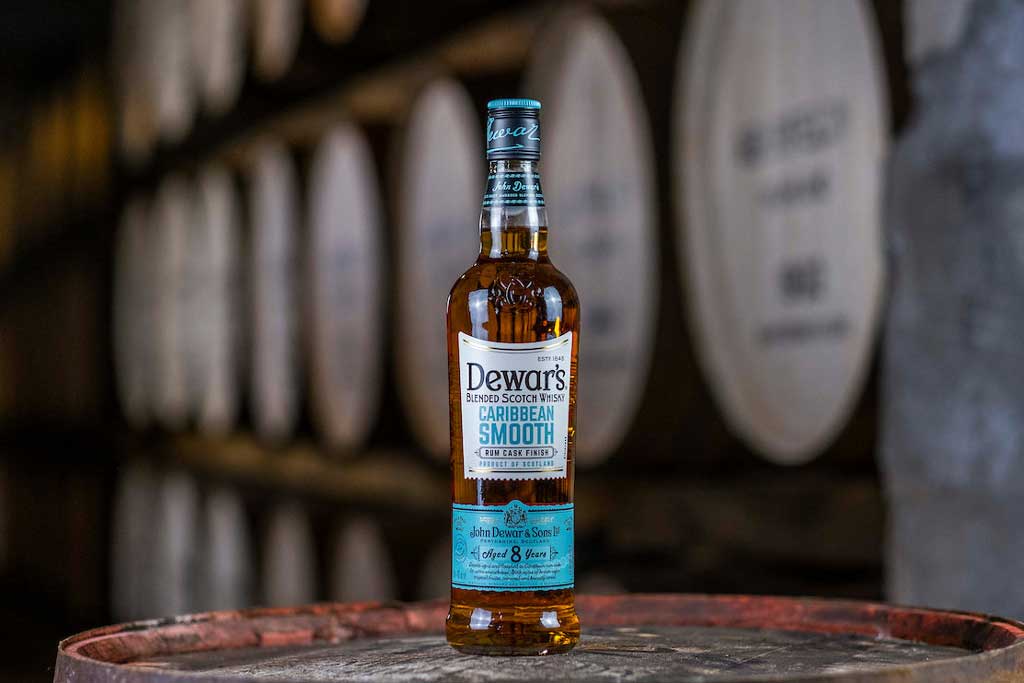
Dewar’s Cask Series
Launched in 2020, the Dewar’s Cask Series explores the effects of cask finishing from different cultures around the world. Using a new 8 year old blend, each of the five bottles are uniquely cask finished for some adventurous and even ground breaking flavours as listed below.
Not only are these whiskies unique and delicious, but they offer great value for money as well; making them the perfect choice for whisky enthusiasts looking for something special.
- Dewar’s Caribbean Smooth (Rum cask finished)
- Dewar’s Illegal Smooth (Mezcal cask finished)
- Dewar’s Portuguese Smooth (Port cask finished)
- Dewar’s Japanese Smooth (Japanese Oak cask finished)
- Dewar’s French Smooth (Calvados cask finished)
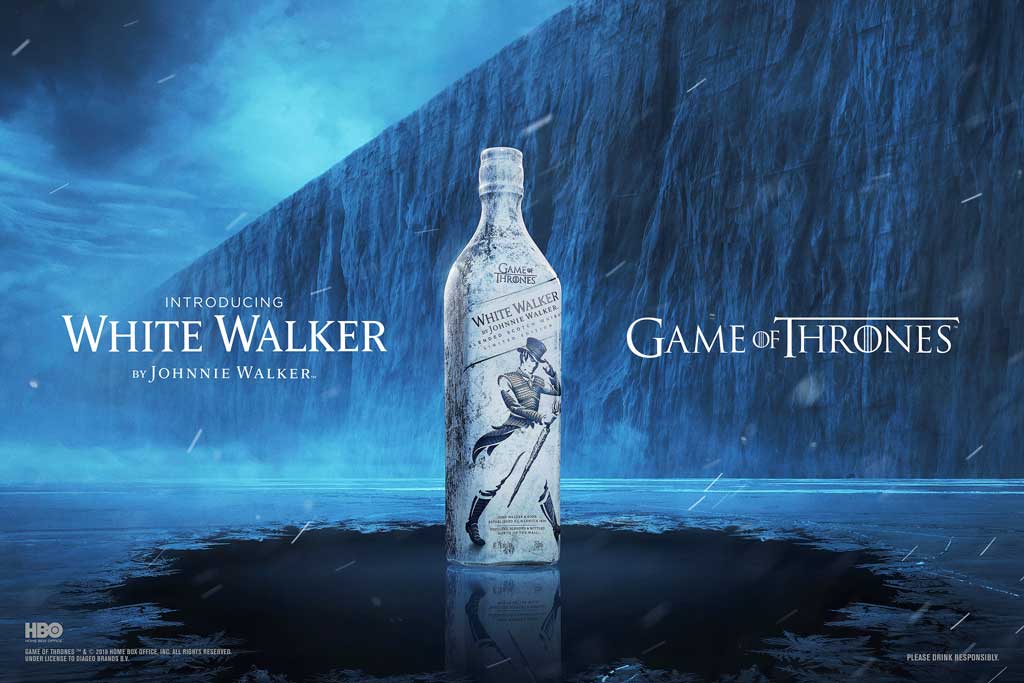
Johnnie Walker White Walker
As a previous collaboration bottle, ‘White Walker’ is a limited-edition whisky inspired by HBO’s hit series Game of Thrones. This special blend was crafted by master blender George Harper and features notes of caramelised sugar and vanilla, red berries, and a hint of orchard fruits.
Focusing towards Scotland’s remote northern distilleries, the whisky has been carefully crafted with single malts including Cardhu and Clynelish to create an icy flavour profile that will transport you right to the frozen north.
With the hit-series has concluding in 2019, it’s hard to track down this limited bottling. If you happen to own or find one, it’ll likely be a collectors item in years to come.


